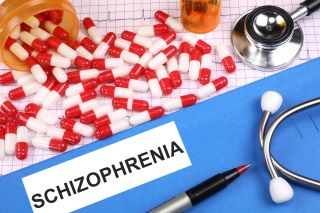Psychopharmacology
Antipsychotic Therapy Since the 1950s: Little Has Changed
After 70 years, the pharmacotherapy of schizophrenia needs changes.
Updated September 25, 2023 Reviewed by Gary Drevitch
Key points
- To date, available antipsychotic medications have been limited to those that act on dopamine and serotonin.
- Although antipsychotics reduce symptoms of schizophrenia, safer and more effective medications are needed.
- Bad luck and financial risk aversion have hampered innovations in antipsychotic drug development.

Since the first antipsychotic medication, chlorpromazine, was developed in the early 1950s, it could be argued that not all that much has changed in the pharmacological treatment of psychotic disorders like schizophrenia.
Clozapine and Second-Generation Antipsychotics
To be sure, the U.S. Food and Drug Administration's (FDA’s) 1989 approval of clozapine brought us an important new “gold standard” to manage “treatment-resistant” schizophrenia that does not respond significantly to other antipsychotic medications. And starting in the 1990s, second-generation antipsychotics (SGAs) offering a substantially lower risk of neurological side effects like tremor, restlessness, muscle stiffness, or the involuntary movements of tardive dyskinesia have gradually replaced the “first-generation” medications.
But while those newer medications have represented upgrades, existing antipsychotic medications still leave a lot to be desired. Despite its superior efficacy, clozapine remains an underutilized “third-line” option due to its risk of serious and potentially life-threatening side effects that require careful monitoring like agranulocytosis (a severe deficiency of white blood cells) and myocarditis. And while it was hoped that other SGAs would replicate the efficacy of clozapine in treatment-resistant schizophrenia without its side effects, they have a variety of side effects of their own, ranging from common problems like sedation, sexual dysfunction, and weight gain to more serious adverse events like diabetes or cardiac arrhythmias. Meanwhile, the use of first-generation medications like chlorpromazine and haloperidol continues in some settings, especially in the public sector where they are often favored over more expensive options.
Further, a third or more of patients with schizophrenia don’t significantly benefit from antipsychotic therapy including clozapine. And medications only help modestly, if at all, with certain types of symptoms of schizophrenia like cognitive impairments or “negative” symptoms such as amotivation. So, clearly, there’s been a longstanding need for better—that is, safer and more effective—medications to treat psychosis.
The "5-HT2, D2, Me Too" Blueprint
It should come as no surprise that, aside from clozapine, the effectiveness of antipsychotic therapy hasn't changed substantially in 70 years if we consider that no antipsychotic medication has ever been developed that doesn’t dampen or otherwise modulate the activity of the neurotransmitter dopamine. Indeed, despite well over a dozen SGAs currently available on the market, their presumed common mechanism of action involving effects on dopaminergic D2 and serotonergic 5-HT2 neurotransmitter receptors make all of them “5-HT2, D2, me too” medications.
Dating back to when the term “schizophrenia” was coined by Eugen Bleuler in 1908, it has always been recognized that schizophrenia isn’t just one disease, but a heterogeneous condition—like high blood pressure—with many different causes. And, so, having only one class of “5-HT2, D2, me too” drugs to treat schizophrenia would be like having only a single class of medication—such as diuretics—to treat high blood pressure, which would be sorely inadequate to remediate its multifactorial causes.
The reason that we haven’t progressed beyond “5-HT2, D2, me too” antipsychotic medications is partly bad luck and partly financial risk aversion. While there have been many attempts to develop antipsychotic medications with novel mechanisms of action through the years, few have proven successful. From selective 5-HT antagonists to neurokinin receptor antagonists, nothing outside of the “5-HT2, D2, me too” blueprint has made it through clinical trials to result in FDA approval. That’s bad luck as well as a reflection of our limited understanding of what schizophrenia really is.
Given this lack of success, there’s been little incentive for drug companies to invest millions to develop new antipsychotic medications if they’re likely to fizzle out in the end. We could compare this situation to the auto industry, in which the success of the four-door sedan, or the two-door pick-up, or the SUV has meant that new cars by different makers are more similar than they are different. Why take a risk on building a new type of car that doesn’t have wheels when you can almost guarantee financial success by building what amounts to a clone of a Honda Accord, Ford F-150, or Toyota RAV-4? That’s financial risk aversion.
Make no mistake: While rare cases of spontaneous recovery can occur, there’s little doubt that taking antipsychotic medications represents the best chance of symptomatic remission for those suffering from chronic symptoms of schizophrenia.1,2 But due to longstanding stagnation in the successful development of novel drugs, I've often said two other things about the state of antipsychotic therap: First, I hope and fully expect that one day people will look back on our current medications as antiquated and sadly inadequate interventions the same way that we now look back on insulin shock therapy or hydrotherapy. And, second, I don’t expect that to happen in my lifetime or at least in my career lifetime.
Drugs in Development
Fortunately, it now seems possible that I might be proven wrong about that second statement because there are two potential new antipsychotic medications on the horizon—ulotaront and xanomeline/tropsium—that have truly novel mechanisms of action. If one of them gains FDA approval in the near future as expected, it could be that we'll finally have different classes of medications to treat schizophrenia, just as we have diuretics, calcium channel blockers, and ACE inhibitors to treat hypertension.
In the next blogpost, I’ll discuss whether these two innovations in antipsychotic drug development could finally pay off by becoming the kind of “game-changers” we’ve been waiting for all these years.
References
1. Pierre JM, Zito MF, Yang YS, Marder SR. Antipsychotic discontinuation and recovery: chicken or egg? Psychological Medicine 2023; 53: 1134–1135.
2. Pierre JM. Do antipsychotics worsen schizophrenia in the long-run? Psych Unseen. Psychology Today. August 8, 2014.




